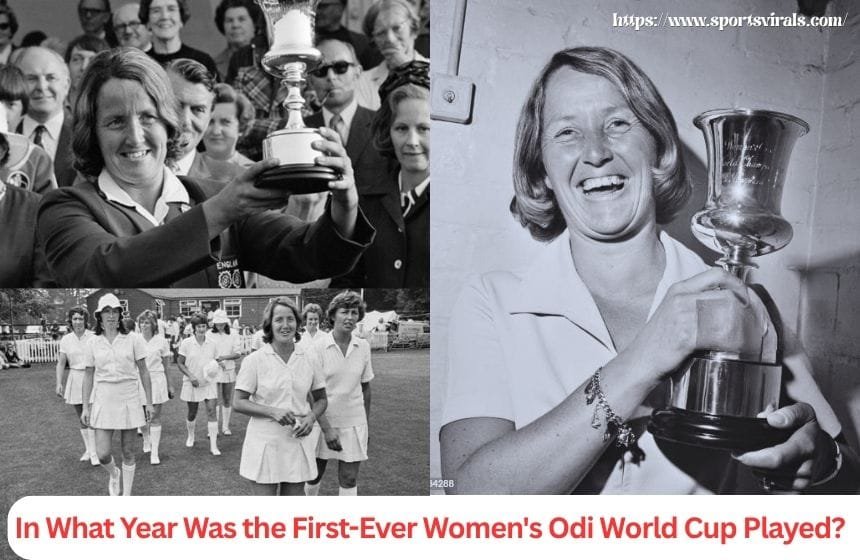The first Women’s ODI World Cup was conducted in 1973, held in two years prior to the Men’s ODI World Cup.
The Introduction of the Women’s One Day International (ODI) World Cup was one of the most important milestones in the history of women’s cricket, which has witnessed explosive growth in the last few decades. This historic event not only proved the talent and perseverance of women cricketers, but it paved the way for the growth and recognition of the sport globally.
In this blog, We will going to provide information about the In What Year Was the First-Ever Women’s Odi World Cup Played? and In Hindi language, people asks pehla women’s odi world cup kab khela gaya tha?
Conception of the Idea
Rachael Heyhoe Flint, an English cricketer, and Sir Jack Hayward, a businessman, collaborated to turn the dream of a women’s cricket world cup into a reality. They devised the idea of the tournament in 1971 and Hayward generously contributed £40,000 towards the cost.
Their ambition came true when England hosted the inaugural Women’s Cricket World Cup from June 20 to July 28. The International Women’s Cricket Council hosted the historic tournament, which used a 60-over format instead of the more popular 50-over one that is used today.
First-Ever Women’s Odi World Cup Journey
- In 1971, Hayward and Heyhoe Flint spent a lot of time and energy organizing this competition. With some deliberation, the concept ultimately turned into a sport that would revolutionize cricket.
- The 1973 Women’s ODI Cricket World Cup was played by seven teams, including a youthful England squad. Teams played for 60 overs rather than 50 in the format used today, and a league table rather than a knockout tournament determined the champions.
- Among the seven teams who competed in the competition were England, Australia, New Zealand, Jamaica, Trinidad & Tobago, Young England and International XI.
- All teams played against each other once during the round-robin portion of the matches.
- The team with the most points at the end of the round-robin matches would be declared the winner.
- Due to this setup, there was no actual final; however, since both Australia and England were at the top of the points table, their last game was technically a de facto final.
The Finals Between England and Australia
England captain Rachael Heyhoe Flint made 64 in the last game, which was held at Edgbaston on July 28. The base for England’s strong 279/3 in their 60 overs came from Enid Bakewell’s 118-run century. Strong England bowling restricted Australia. England defeated Australia by 92 runs as Australia fared poorly in their pursuit, only managing to score 187/9.
Prime Minister Edward Heath hosted a banquet at 10 Downing Street in honor of the players following Princess Anne presenting the trophy to the victorious English team. The most wickets were taken by Rosalind Heggs of Young England (12), and Enid Bakewell of team England was the top scorer in the tournament with 264 runs.
Significance of the 1973 Women’s ODI World Cup
The 1973 Women’s World Cup was a powerful statement about gender equality in sport and was considerably more than a competition. It proved women’s cricket had a role to play on the international stage and could be funded and recognized. Women’s cricket gained widespread recognition as a result of the tournament’s success.
Women playing cricket internationally was becoming accepted. The media exposure also grew with much more viewers watching to view the tournament, particularly the final between England and Australia.
The success also ensured that the women’s ODI World Cup will come back and it once again occurred in 1978. It also encouraged cricket boards to support and develop women’s teams of their own. Millions of spectators watch the leading players battle it out in the ICC Women’s Cricket World Cup, a high-profile and highly viewed international tournament.
Although the 1973 tournament lacked the publicity and media coverage enjoyed today, successive generations of women’s cricket players continue to be inspired by its heritage.
Conclusion
In addition to being a contest, the 1973 Women’s Cricket World Cup was a landmark event that elevated the status of women’s cricket.
It motivated future generations and provided a foundation for the development of regular international competitions by highlighting the possibilities and competitiveness of women’s cricket. In retrospect, the 1973 Women’s Cricket World Cup is an appreciation of the determination and vision of its organizers and participants.
Apart from providing women cricket players with a platform upon which they could showcase their talent, it paved the way for women’s cricket to expand and professionalize globally.
Refresh Date: August 19, 2025






